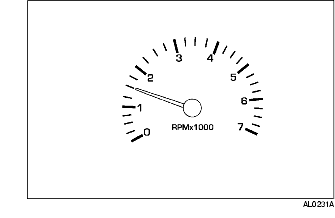REFRIGERANT SYSTEM TESTS
id071000800900
1. Adjust the climate controls for maximum cooling.
-
(1) Start the engine.
-
(2) Select MAX COLD operation.
-
(3) Set the blower motor speed to maximum.
2. Stabilize the in-vehicle temperature at 21-27 ×C {70-80 ×F}.
3. Maintain the engine speed at 1,500 rpm.
-
Note
-
• When the ambient temperatures exceed 38 ×C {100 ×F}, do not run the engine above normal idle speed.
4. Determine the compressor discharge (high) pressure.
-
(1) Record the ambient temperature.
-
(2) Record the discharge (high) pressure.
-
(3) The system performance is acceptable when the pressure reading falls between the upper and lower limits shown.
-
Note
-
• In ambient temperatures between 38-43 ×C {100-110 ×F}, the system performance pressures will be the same as those for ambient temperatures shown on the chart in the 32-38 ×C {90-100 ×F} range.
5. Determine the compressor suction (low) pressure.
-
(1) Record the ambient temperature.
-
(2) Record the suction (low) pressure.
-
(3) The system performance is acceptable when the pressure reading falls between the upper and lower limits shown.
-
Note
-
• In ambient temperatures between 38-43 ×C {100-110 ×F}, the system performance pressures will be the same as those for ambient temperatures shown on the chart in the 32-38 ×C {90-100 ×F} range.
6. Determine the magnetic clutch ON time.
-
(1) Record the ambient temperature.
-
(2) Record the magnetic clutch ON time in seconds.
-
(3) The system performance is acceptable when the recorded time falls between the upper and lower limits shown.
-
Note
-
• When the ambient temperature is above 26 ×C {80 ×F}, the magnetic clutch may not cycle.
7. Determine the magnetic clutch OFF time.
-
(1) Record the ambient temperature.
-
(2) Record the magnetic clutch OFF time in seconds.
-
(3) The system performance is acceptable when the recorded time falls between the upper and lower limits shown.
-
Note
-
• When the ambient temperature is above 26 ×C {80 ×F}, the magnetic clutch may not cycle.
8. Determine the total magnetic clutch cycle time.
-
(1) Record the ambient temperature.
-
(2) Record the time the magnetic clutch is engaged plus the time it is disengaged (time ON plus time OFF).
-
(3) The system performance is acceptable when the recorded time falls between the upper and lower limits shown.
-
Note
-
• When the ambient temperature is above 26 ×C {80 ×F}, the magnetic clutch may not cycle.
9. Determine the magnetic clutch cycle rate per minute.
-
(1) Record the ambient temperature.
-
(2) Record the number of magnetic clutch cycles occurring in one minute.
-
(3) The system performance is acceptable when the recorded number of cycles falls between the upper and lower limits shown.
-
Note
-
• When the ambient temperature is above 26 ×C {80 ×F}, the magnetic clutch may not cycle.
10. Determine the center A/C register discharge temperature.
-
(1) Record the ambient temperature.
-
(2) Record the center A/C register discharge temperature.
-
(3) The system performance is acceptable when the center A/C register discharge temperature falls between the upper and lower limits shown.
-
Note
-
• In ambient temperatures between 38-43 ×C {100-110 ×F}, the A/C register discharge temperatures will be the same as those for ambient temperatures shown on the chart in the 32-38 ×C {90-100 ×F} range.
